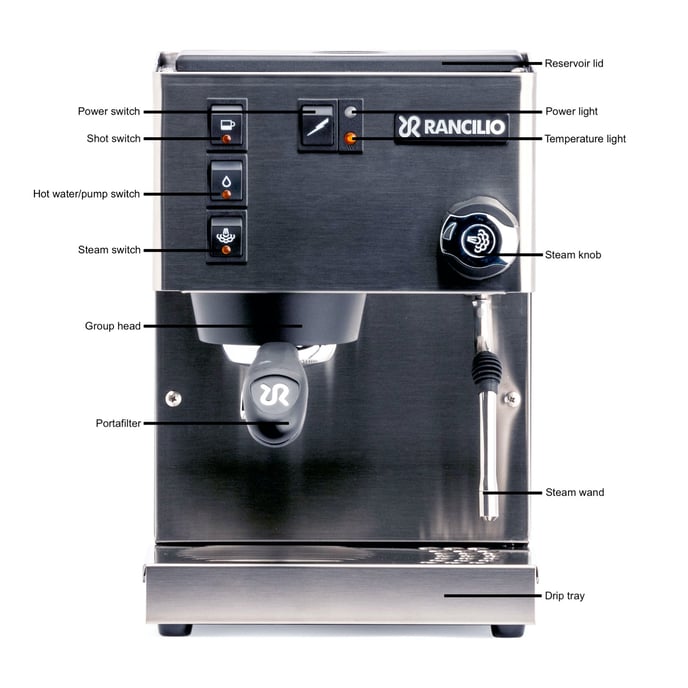Rancilio Silvia: User Manual
Set Up Your Rancilio Silvia. In this manual, you should find everything you to need to operate and maintain your single boiler, saturated group espresso machine.
Please read carefully before using your Rancilio Silvia Espresso Machine.
If you have any other questions, be sure to contact us.
Included Accessories:
- Double spouted portafilter
- Single basket (7g)
- Double basket (18g)
- Backflush rubber insert
- Black wood-handled tamper
Water
Espresso machines have specific water requirements. Two primary considerations are filtration and hardness.
Filtration removes tiny particles, such as sand or rust, from your water. If these particles were allowed to enter your machine, they could cause all manner of trouble, specifically by clogging the small valves and other parts in your espresso machine. Almost any water filter will do the job, whether it’s the one built into your fridge, a Brita, or a whole-house filter. Ensuring that this filter is replaced at the proper time will be essential to ensure machine health.
Water hardness is equally essential. Ideally, we want a hardness of between 35-85 ppm (parts per million). Hardness refers to the dissolved solids or mineral content in your water. Common dissolved solids are things like magnesium, calcium, and various forms of sodium. These dissolved solids are what make water, and therefore espresso, taste good. But an excess will result in scale buildup inside your machine. Scale can cause irreparable damage to your machine by clogging and forming a mineralized layer over the surface of metal parts. The process of descaling is even more damaging, eating away at the machine’s metal internals. Luckily, the buildup can be entirely avoided by keeping your water hardness within the recommended TDS range of 35-85 ppm.
There are numerous methods to soften your water if the mineral content has been tested to be too high for your machine.
- A Note on RO (Reverse Osmosis) or Distilled Water
Taste aside, espresso machines require some mineral content to function properly. Their steam boiler fill probes, in particular, use the conductivity of water to detect the water level. With no dissolved solids, they’ll overfill, giving you water instead of steam. You must add some mineral content back in. Our recommendation is Third Wave Water packets, designed to offer ideal flavor and be safe for your machine.
- Reservoir Solutions
Our first recommendation is an in-tank water softening pouch. They’re affordable, last 4-6 months, and very effective. Using distilled water purchased by the gallon in combination with Third Wave Water packets is another effective option.
No matter what solution you pick, we recommend testing the water coming from your machine’s group head every few months. City water hardness changes seasonally, and softening systems wear out. Quarterly testing will ensure you keep your machine safe.
- First Time Setup with Reservoir
First, fill the reservoir with your filtered and softened water, leaving a few inches at the top to prevent spillage. Ensure that you do not spill water on top of the machine when filling, as this may cause electrical damage. When filling the reservoir, verify that the rubber/plastic water intake line is arranged such that it is fully submerged and touches the bottom of the reservoir.
Once your reservoir is filled, you will need to manually fill the boiler before pulling shots. Follow the instructions below to ensure this process is done properly.
- Plug in your machine and turn on the power switch.
- Grab a pitcher or cup, open the steam wand, and press the hot water button. The pump will engage right away. Once a steady stream of water comes through the steam wand, you will know the boiler is full. Stop the pump by pressing the hot water button again.
- After the boiler has filled, you’ll also need to pull water through your group head. Press the shot button to activate the pump. Once at least 4 ounces of water has run through the group head, push the shot button again to stop the water flow and insert your portafilter.
- At this point, you’ll have used most of the water in the reservoir. We’d recommend refilling your reservoir now to avoid running out of water.
- Once the orange indicator light turns off, you’re ready to start pulling shots!
Steam Mode
Since the Silvia is a single-boiler espresso machine, you will need to switch between a brewing temperature for pulling shots and a higher steam temperature. Follow the instructions below to enter the machine's steam mode.
- Press the steam switch.
- Purge some of the water from the steam wand to make room in the boiler for steam.
- Rotate the steam knob to purge the wand for 5 seconds, then turn it off and wait about 45 seconds to a minute until the heat indicator light has shut off.
- Purge the steam wand for another 5 seconds, and by now, you should see a healthy amount of steam coming through the steam tip.
- You’re now ready to start steaming! When you’ve finished steaming, press the steam button again to return to brewing mode. Do not leave the Silvia in its steam mode for longer than a few minutes. This may cause damage to the heating element.
Technical Details
For a complete list of technical details, please see the spec table on our product page.
Now you're ready to start pulling shots! Check out our Espresso 101 section to learn about steaming milk, latte art, our suggested starter espresso recipe, grinder dial-in tips, and much more.
Helpful Links
- Espresso 101
- More on Water and Setup
- Clive Blog
- Espresso Machine Cleaning & Maintenance
- Manufacturer's Manual
Still have questions? Reach out to our coffee experts and technicians.
